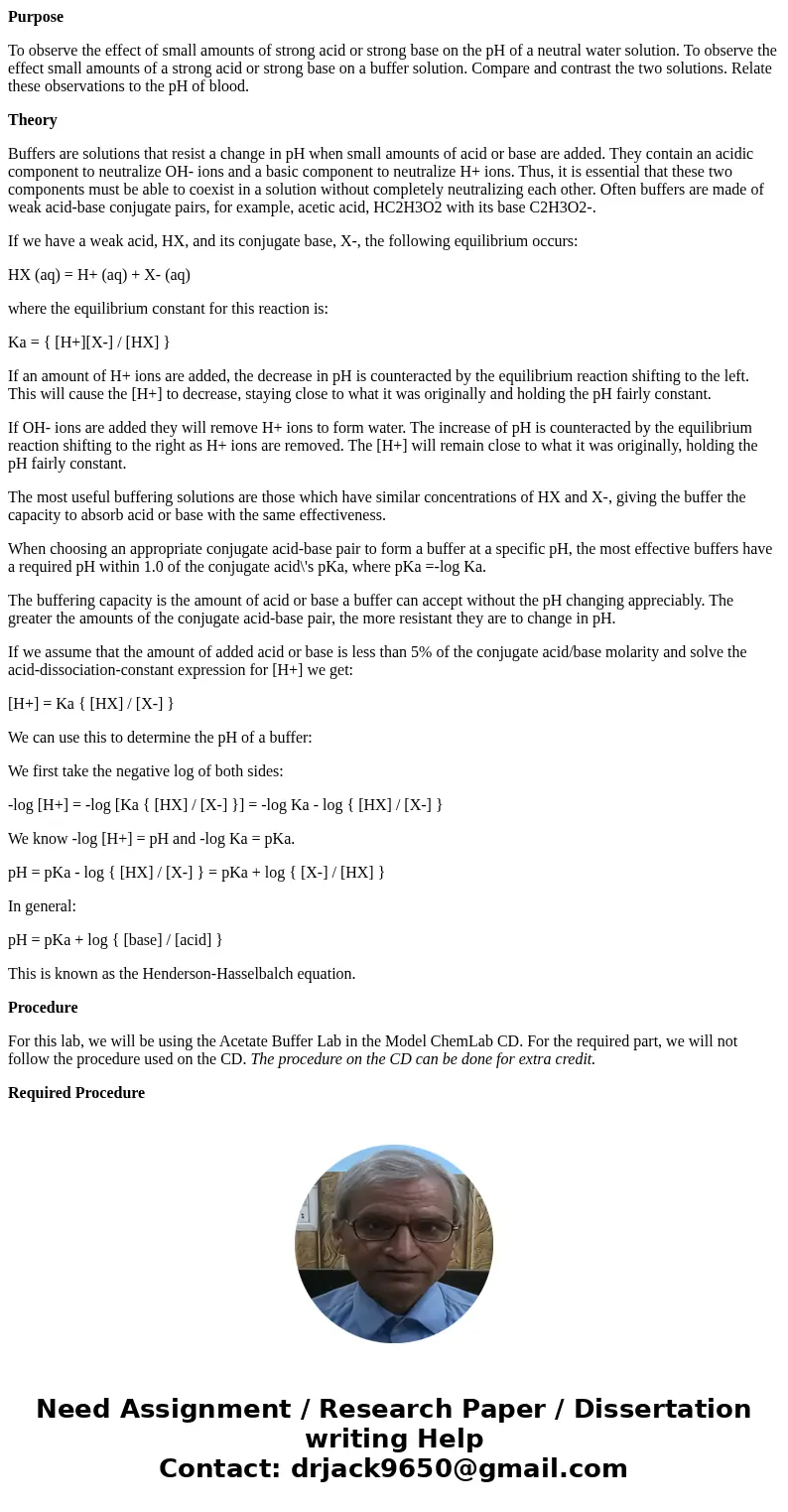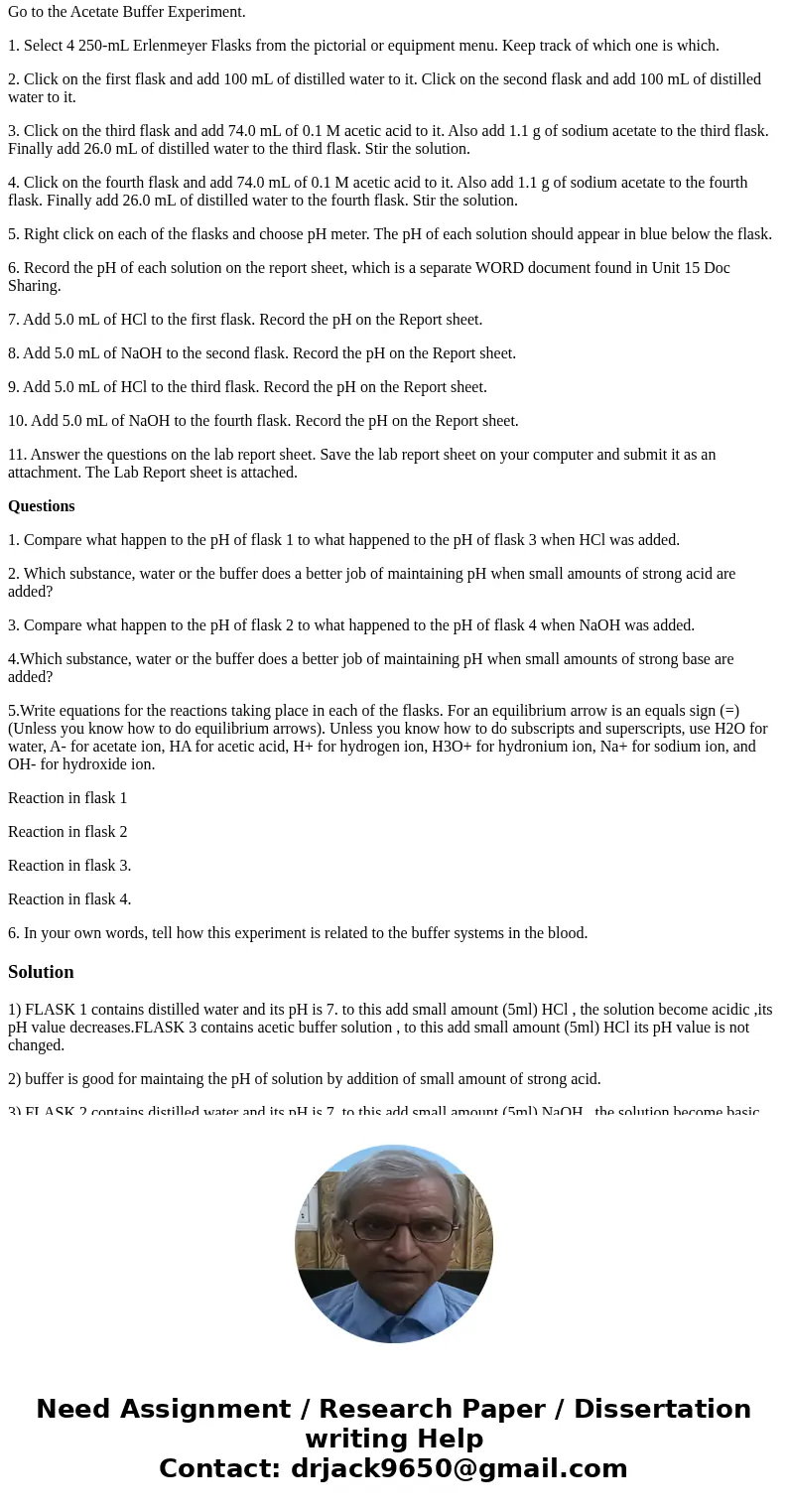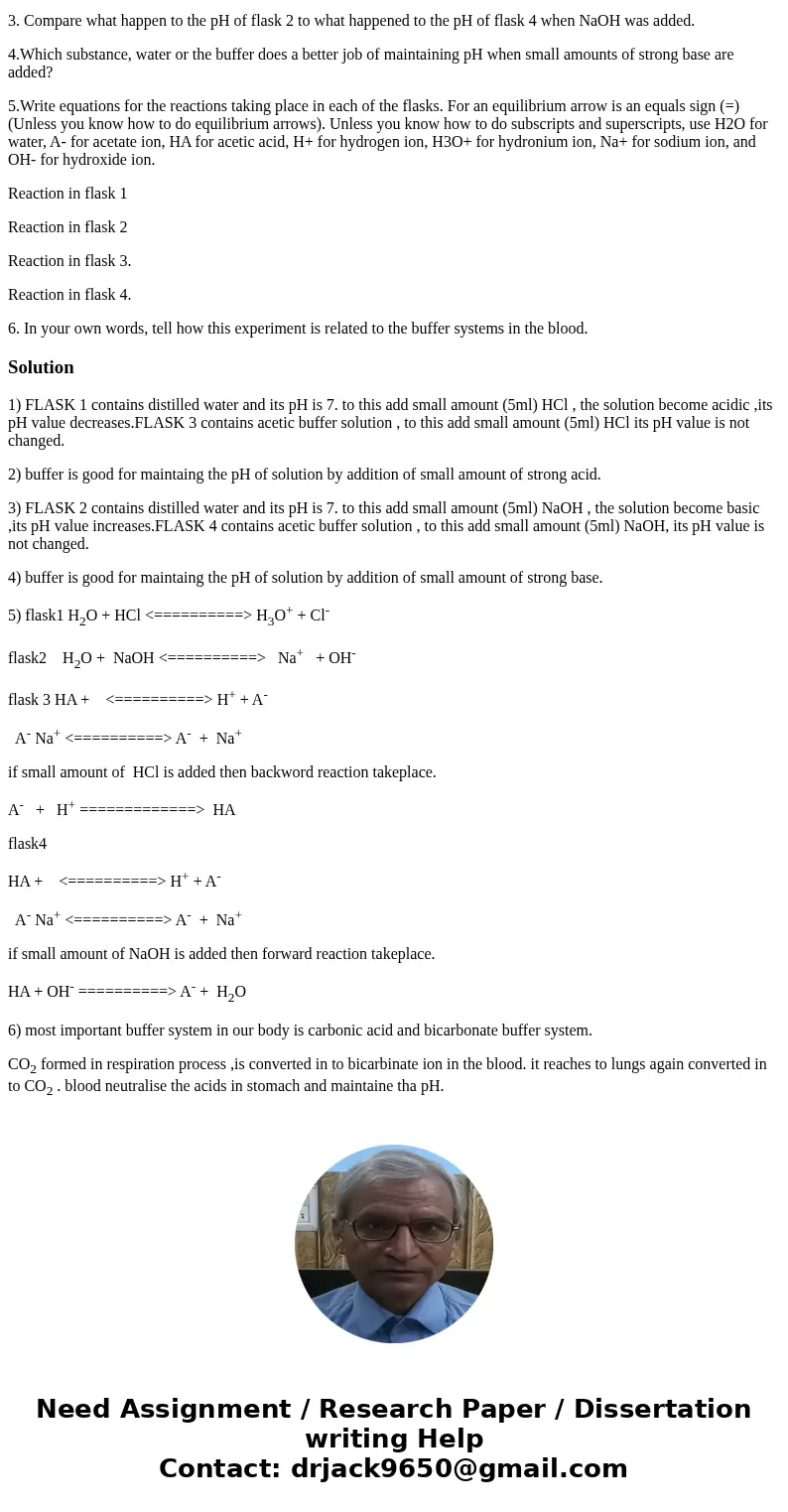Purpose To observe the effect of small amounts of strong aci
Purpose
To observe the effect of small amounts of strong acid or strong base on the pH of a neutral water solution. To observe the effect small amounts of a strong acid or strong base on a buffer solution. Compare and contrast the two solutions. Relate these observations to the pH of blood.
Theory
Buffers are solutions that resist a change in pH when small amounts of acid or base are added. They contain an acidic component to neutralize OH- ions and a basic component to neutralize H+ ions. Thus, it is essential that these two components must be able to coexist in a solution without completely neutralizing each other. Often buffers are made of weak acid-base conjugate pairs, for example, acetic acid, HC2H3O2 with its base C2H3O2-.
If we have a weak acid, HX, and its conjugate base, X-, the following equilibrium occurs:
HX (aq) = H+ (aq) + X- (aq)
where the equilibrium constant for this reaction is:
Ka = { [H+][X-] / [HX] }
If an amount of H+ ions are added, the decrease in pH is counteracted by the equilibrium reaction shifting to the left. This will cause the [H+] to decrease, staying close to what it was originally and holding the pH fairly constant.
If OH- ions are added they will remove H+ ions to form water. The increase of pH is counteracted by the equilibrium reaction shifting to the right as H+ ions are removed. The [H+] will remain close to what it was originally, holding the pH fairly constant.
The most useful buffering solutions are those which have similar concentrations of HX and X-, giving the buffer the capacity to absorb acid or base with the same effectiveness.
When choosing an appropriate conjugate acid-base pair to form a buffer at a specific pH, the most effective buffers have a required pH within 1.0 of the conjugate acid\'s pKa, where pKa =-log Ka.
The buffering capacity is the amount of acid or base a buffer can accept without the pH changing appreciably. The greater the amounts of the conjugate acid-base pair, the more resistant they are to change in pH.
If we assume that the amount of added acid or base is less than 5% of the conjugate acid/base molarity and solve the acid-dissociation-constant expression for [H+] we get:
[H+] = Ka { [HX] / [X-] }
We can use this to determine the pH of a buffer:
We first take the negative log of both sides:
-log [H+] = -log [Ka { [HX] / [X-] }] = -log Ka - log { [HX] / [X-] }
We know -log [H+] = pH and -log Ka = pKa.
pH = pKa - log { [HX] / [X-] } = pKa + log { [X-] / [HX] }
In general:
pH = pKa + log { [base] / [acid] }
This is known as the Henderson-Hasselbalch equation.
Procedure
For this lab, we will be using the Acetate Buffer Lab in the Model ChemLab CD. For the required part, we will not follow the procedure used on the CD. The procedure on the CD can be done for extra credit.
Required Procedure
Go to the Acetate Buffer Experiment.
1. Select 4 250-mL Erlenmeyer Flasks from the pictorial or equipment menu. Keep track of which one is which.
2. Click on the first flask and add 100 mL of distilled water to it. Click on the second flask and add 100 mL of distilled water to it.
3. Click on the third flask and add 74.0 mL of 0.1 M acetic acid to it. Also add 1.1 g of sodium acetate to the third flask. Finally add 26.0 mL of distilled water to the third flask. Stir the solution.
4. Click on the fourth flask and add 74.0 mL of 0.1 M acetic acid to it. Also add 1.1 g of sodium acetate to the fourth flask. Finally add 26.0 mL of distilled water to the fourth flask. Stir the solution.
5. Right click on each of the flasks and choose pH meter. The pH of each solution should appear in blue below the flask.
6. Record the pH of each solution on the report sheet, which is a separate WORD document found in Unit 15 Doc Sharing.
7. Add 5.0 mL of HCl to the first flask. Record the pH on the Report sheet.
8. Add 5.0 mL of NaOH to the second flask. Record the pH on the Report sheet.
9. Add 5.0 mL of HCl to the third flask. Record the pH on the Report sheet.
10. Add 5.0 mL of NaOH to the fourth flask. Record the pH on the Report sheet.
11. Answer the questions on the lab report sheet. Save the lab report sheet on your computer and submit it as an attachment. The Lab Report sheet is attached.
Questions
1. Compare what happen to the pH of flask 1 to what happened to the pH of flask 3 when HCl was added.
2. Which substance, water or the buffer does a better job of maintaining pH when small amounts of strong acid are added?
3. Compare what happen to the pH of flask 2 to what happened to the pH of flask 4 when NaOH was added.
4.Which substance, water or the buffer does a better job of maintaining pH when small amounts of strong base are added?
5.Write equations for the reactions taking place in each of the flasks. For an equilibrium arrow is an equals sign (=) (Unless you know how to do equilibrium arrows). Unless you know how to do subscripts and superscripts, use H2O for water, A- for acetate ion, HA for acetic acid, H+ for hydrogen ion, H3O+ for hydronium ion, Na+ for sodium ion, and OH- for hydroxide ion.
Reaction in flask 1
Reaction in flask 2
Reaction in flask 3.
Reaction in flask 4.
6. In your own words, tell how this experiment is related to the buffer systems in the blood.
Solution
1) FLASK 1 contains distilled water and its pH is 7. to this add small amount (5ml) HCl , the solution become acidic ,its pH value decreases.FLASK 3 contains acetic buffer solution , to this add small amount (5ml) HCl its pH value is not changed.
2) buffer is good for maintaing the pH of solution by addition of small amount of strong acid.
3) FLASK 2 contains distilled water and its pH is 7. to this add small amount (5ml) NaOH , the solution become basic ,its pH value increases.FLASK 4 contains acetic buffer solution , to this add small amount (5ml) NaOH, its pH value is not changed.
4) buffer is good for maintaing the pH of solution by addition of small amount of strong base.
5) flask1 H2O + HCl <==========> H3O+ + Cl-
flask2 H2O + NaOH <==========> Na+ + OH-
flask 3 HA + <==========> H+ + A-
A- Na+ <==========> A- + Na+
if small amount of HCl is added then backword reaction takeplace.
A- + H+ =============> HA
flask4
HA + <==========> H+ + A-
A- Na+ <==========> A- + Na+
if small amount of NaOH is added then forward reaction takeplace.
HA + OH- ==========> A- + H2O
6) most important buffer system in our body is carbonic acid and bicarbonate buffer system.
CO2 formed in respiration process ,is converted in to bicarbinate ion in the blood. it reaches to lungs again converted in to CO2 . blood neutralise the acids in stomach and maintaine tha pH.



 Homework Sourse
Homework Sourse